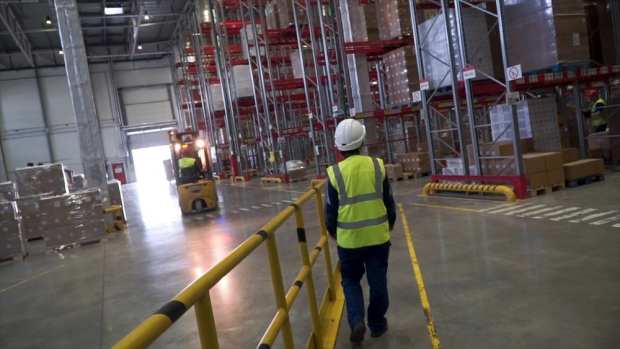Why Robotization Is Critical To Amazon’s One-Day Shipping Vision

Cathryn Kachura is a a “flow control specialist” at Amazon’s Denver, Colorado sortation center, an extra-large warehouse that is informally known as the “robot highway.” Flow control specialists are the traffic agents on the highway, and their job is to keep real-time track of the volume of packages moving across the massive warehouse and Kachura’s job is to make sure the machines don’t end up locked in a traffic jam or malfunctioning.
Kachura originally applied as a temporary worker, she noted in a video produced by Amazon in which she discusses her daily responsibilities and says, “If you had told 10-year-old me that my job would revolve around robots every day, there’s no way I would have believed you.”
This picture of human employees working side-by-side with Amazon’s ever-increasing amount of automation technology was a often repeated theme at Amazon’s first-ever re:MARS conference in Las Vegas last week — and devoted to, in Amazon’s words, “Machine Learning, Automation, Robotics, and Space.”
And with the confirmation that the firm already had 200,000 robotic drives actively employed worldwide and that delivery drones will be taking to the sky in the very near future, one thing is very clear this week: Automation isn’t Amazon’s future, it is its present, and it is critical to advancing the firm’s recently-announced initiative to turn Prime two-day shipping into Prime one-day shipping.
Riding the Pegasus
The most commonly used robot at the sortation center (and in a handful of other sortation center warehouses) is described as resembling a large rolling suitcase with a conveyor belt on top. It’s call a Pegasus, and its function is to delivery packages to chutes where they are organized by ZIP code and sent off to customers.
These robots are considerably less famous than the winged horses they are named after, but they’ve done a lot of work in a short time. According to Amazon’s estimates, they’ve logged about1.5 million miles of driving and greatly improved Amazon’s speed and accuracy in moving packages into the logistics chain.
“We sort billions of packages a year,” said Brad Porter, vice president of robotics at Amazon, according to GeekWire. “The challenge in package sortation is, how do you do it quickly and accurately?
Porter when on to note that one-day delivery is entirely dependent on accuracy — because one slight slip mostly makes it impossible.
“If you drop a package off a conveyor, lose track of it for a few hours — or worse, you mis-sort it to the wrong destination, or even worse, if you drop it and damage the package and the inventory inside — we can’t make that [one-day] customer promise anymore,” he said.
The Human Factor
The footprint for Pegasus remains small; it is not yet a feature in the majority of Amazon’s sortation centers, of which there are about 40 worldwide. But the robots are coming.
But humans, Amazon has repeatedly noted, are not going anywhere, because the robots rely on people like Cathryn Kachura to monitor them, and make sure they ware workign correctly. How many human workers to robots are necessary is unknown — Amazon hasn’t disclosed that figure on the grounds that warehouse employment varies depending on seasons and location.
The company said it’s also difficult to reveal the number of workers employed inside warehouses without robots.
Apart from the care and maintenance of robots, Amazon says human workers in its factories are managers, safety engineers and “amnesty workers,” who are trained to go on to the floor to fix a robot or pick up packages that may have fallen on the ground.
Amazon has further confirmed that it will be expanding the robot assistance to more of its U.S.-based sortation centers this year — though the timeline remains hazy.
The timeline for automated delivery, via drone, however, got a major bit of clarification, with Amazon announcing drone delivery service will be available in the U.S. within months, according to a report by Reuters.
The drone delivery initiative by Amazon is not new, and the company has been talking about it for a number of years, but this is the first time it has had a release date attached. Amazon has confirmed the fully electric drones can fly up to 15 miles and they will build more storage facilities closer to urban areas to better support them. The drones can transport packages under five pounds, which covers the majority of what the eCommerce retailer sells.
